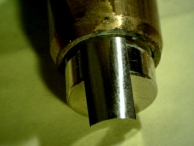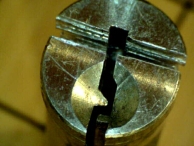Lock Disassembly
This page discusses different ways to disassemble a lock as well as vivisect it for laboratory investigations. Different jurisdictions have different preferences as to how evidence is handled and examined, but these techniques are chosen because of their minimal impact on evidence and the forensic process.
In order to do laboratory examinations, components must first be properly removed from the lock. This can be a simple or arduous task depending on the lock in question. In most cases the forensic locksmith will not be given a working key to a cylinder, and must open it in another way. Obviously, the investigator cannot pick or bump the lock open. When disassembling the cylinder, all components must be kept in their original position, order, and, if possible, alignment. The best way to accomplish the first two items is by using a pinning tray to organize components as they are removed from the lock. In the case of wafer and lever locks, components should be laid out according to their proper position and order.
In all cases it is essential that the lock and door are thoroughly examined before being disassembled. Clues as to method of entry and tools used may be better seen when the lock is mounted, where the lock can be examined alongside the door and other surroundings.
See the Tools and Workspaces page for more information on tools used during disassembly of the lock.
Non-destructive Disassembly
The absolute best method of disassembly of the lock is taking it apart without damaging it or using a key to open it. In pin-tumbler cylinders this means proper removal from the door and then removal of the pin-chamber screws, casings, or cover. In combination, lever, and warded locks this usually means simply removing the lock from the door and removing any casing screws. Most American locks are easy to disassembly in this way, but many European profile locks do not have exposed pin-chamber screws or casings.
Rapping
Rapping is a non-destructive method of opening a pin-tumbler cylinder without affecting internal components. Rapping is similar, in function, to key bumping, but without the forensic implications. To rap a lock: light torque is applied to the plug or cam with one hand, the other hand uses a rubber mallet to gently hit the bottom of the cylinder, cause kinetic energy to transfer to top pins. If all top pins jump above the shear-line the plug will turn. Unlike bumping, rapping leaves no forensic evidence because it does not use a key to transfer kinetic energy. This method is not terribly effective, but it is worth trying because it does not affect forensic evidence inside the lock.
Shimming

Shimming is a non-destructive method of opening a pin-tumbler cylinder that uses a thin piece of metal to separate pin pairs at the shear-line. Shimming is mildly invasive, but generally does not leave forensic evidence in places that are normally accessible by compromise tools. To shim a lock, a blank key and a shim are obtained. The blank key is inserted into the lock, then a shim is inserted from the back of the lock, between the plug and cylinder. The blank key is slowly withdrawn while light pressure is applied to the shim. As the pin pairs reach the shear-line the shim slips between them, trapping top pins above the shear line. This process repeats until the shim separates all pin pairs and the plug is free to rotate. The photo shows a shim partially inserted between the plug and cylinder.
Destructive Methods
Destructive methods are not popular to initially disassemble the lock, but may be required in the case of padlocks or when use of a key or shim is not preferred. A working knowledge of the anti-drilling, cutting, and other security features of the lock is an absolute necessity to properly disassemble the lock as well as protect the well-being of the forensic locksmith. The lock is destroyed only enough to remove the internal components and nothing more. Pictures and documentation must be done throughout every step of the process to ensure that it can be verified and was done properly.

One place where destructive methods are very useful is in the vivisection of lock components. This is not a big issue with lever, combination, and warded locks, but pin-tumbler and wafer based cylinders provide a wealth of information when their plugs are dissected. The preferred method for vivisecting the plug is into thirds, not cut down the middle as may be expected (see photo). Cutting into thirds is preferred over halves because the top portion of the keyway is never touched by components, including the key, and is considered virgin territory where forensic evidence may be present. See the lockpicking page for more information of possible marks in this area. To cut the plug, a fine-tooth hacksaw or jeweler's saw is used.
Use of a key
Though it may seem natural to use a working key to aid in disassembly of the lock it is generally frowned upon. The last object to enter the lock was that key and it may have destroyed or created evidence. Use of a key may only be done in situations where destructive methods are not allowed and there is no other way to disassemble the lock.

